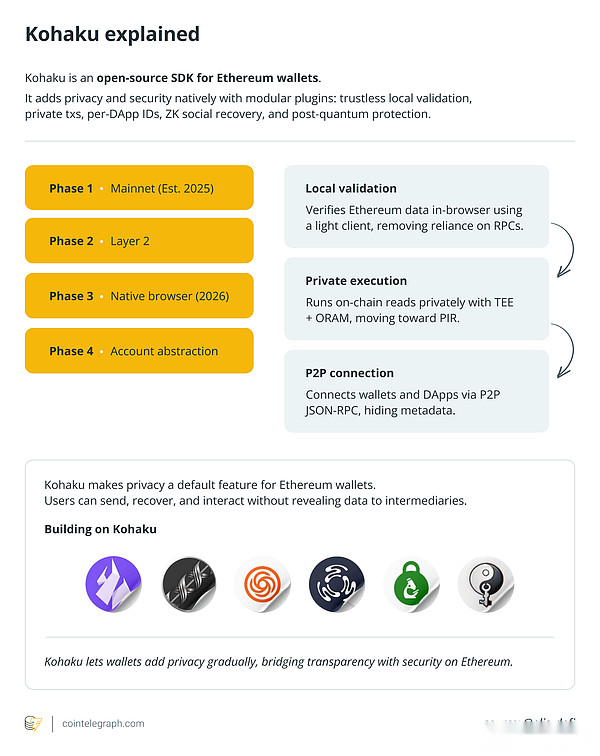
Deng Tong, Bitcoin Vision
From November 17th to 22nd, 2025, the Ethereum Developer Conference was held in Buenos Aires, Argentina. More than 75 teams attended this event.At this developer conference, DeFi, social, hardware and wallets, games, artificial intelligence, L2 and NFT, etc. all allowed attendees to witness more possibilities in the encryption world.One of the most eye-catching is the series of discussions on “privacy”.
Aztec, Fileverse, Holonym, Fluidkey, Rarimo (Unforgettable), Railgun, ZKPassport, 0xbow, NYM and other projects have appeared in the privacy zone.
1. Vitalik releases Kohaku, an Ethereum privacy protection encryption tool
When Vitalik Buterin took the stage to demonstrate Kohaku, he bluntly summed up the current state of Ethereum.The network has strong security and privacy research and solid Layer-1 security mechanisms.But it still doesn’t have the “last mile of upgrades,” which is the wallets and apps that users actually use.
In theory, Ethereum has been leading the way for the past decade.The emergence of elliptic curve precompilation in 2018 paved the way for the emergence of zero-knowledge succinct non-interactive knowledge arguments (zk-SNARKs) and privacy tools such as Tornado Cash and Railgun.The DAO hack of 2016 prompted rigorous auditing across the ecosystem, driving demand for powerful wallets like Gnosis Safe and transforming multisig from a niche concept to a standard practice.
However, in 2025, it still feels clunky for everyday personal use.People need to remember additional mnemonics, install specialized wallets, and often choose to use centralized exchanges because they are easier to operate.
Kohaku is the solution for Ethereum.

1.What is Kohaku?
Kohaku can be understood as Ethereum’s new privacy and security toolkit for wallets.
For developers, the Ethereum Foundation provides an open source framework that includes a modular software development kit (SDK) and a reference wallet.The SDK provides reusable components for private sending, more secure key management and recovery, and risk-based transaction controls so teams don’t have to build the entire privacy protocol stack from scratch.
For users, the first version is a browser extension wallet for advanced users, built on top of Ambire.It supports private and public transactions, separate accounts for each decentralized application, peer-to-peer broadcasting (rather than centralized relays), and tools for hiding Internet Protocol (IP) addresses and other metadata as much as possible.
Kohaku’s underlying architecture integrates seamlessly with existing Ethereum privacy tools such as Railgun and Privacy Pools, rather than developing new mixers or second-layer networks.This allows Kohaku to focus on what’s really missing: a unified wallet architecture with privacy, recovery, and security built in from the start, rather than being added incrementally as experimental add-ons.
2. How does Kohaku work?
At its core, Kohaku is less of a “big app” and more of a bunch of Lego bricks for building a private, more secure wallet.
1) Wallet architecture
Rather than a single master key, Kohaku-style wallets are designed with multiple keys with different roles, a risk-based approval mechanism, and a recovery process that does not rely on a single mnemonic phrase written down on paper.
Transferring $100,000 triggers additional review and confirmation procedures, while transferring $10 does not.This is exactly the risk-based capital access mechanism that Vitalik has been promoting.
2) Protective measures
Kohaku doesn’t keep all its transactions hidden.It allows the wallet to provide both public and private key modes.After selecting private key mode, the wallet can be routed through protocols such as Railgun or Privacy Pools, generating new, unlinkable payment addresses and minimizing the on-chain footprint.Tools such as association lists are built into the design so that the team can stop obvious illicit financial flows without stripping other users of their privacy.
3) Online privacy
Finally, the roadmap not only covers writing data to the chain, but also extends to reading and network privacy aspects.Kohaku is designed to plug into hybrid networks to hide IP-level metadata, and ultimately into zero-knowledge browsers or remote procedure call (RPC) schemes, ensuring that even checking your balance or reading decentralized application data does not quietly reveal your identity and actions.

3.Why Kohaku is so important
Kohaku is important because it solves a problem that Ethereum has struggled with for years: the point at which real users interact with the blockchain.
Over the years, research teams have continued to introduce faster proofs, more efficient cryptographic primitives, and more secure contract models.But on Kohaku, Buterin’s complaints are more practical: extra mnemonics, private pools not supporting multi-signatures, unreliable broadcasts, and cumbersome processes force users back to centralized exchanges because they are more convenient.
By focusing on wallets, Kohaku gives L2 networks and DApps what they have been missing: a shared, privacy-focused infrastructure.In the past, each rollup or application needed to develop its own hidden address system, recovery process and large transfer warning mechanism, but Kohaku provides a set of patterns and codes that all applications can rely on.This is crucial in an ecosystem that increasingly exhibits an intertwined network of rollups rather than a single blockchain structure.
Since Kohaku is derived from the core Ethereum ecosystem rather than a startup’s wallet, it has the potential to become the reference model that other wallets need to match or surpass.
Kohaku also forces Ethereum to face some tough issues.
-
First, it is crucial to walk the line between maximum privacy and responsible privacy.Association lists, auditable privacy shields and risk-based controls are exactly what regulators and banks want to see.However, for some users, any selective privacy visibility or blacklisting practices feel like the beginning of a slide into the abyss.Kohaku doesn’t end the debate, it just makes the contradiction more obvious.
-
In addition, there are technical risks.Wallets that manage multiple keys, recovery paths, privacy switches, different broadcast options, and plugin modules have a greater attack surface than simple mnemonic sending wallets.This requires rigorous auditing and clear rules for upgrades and default settings.
-
Then there’s the practical matter of user experience (UX).A framework can provide some good patterns, but it cannot force teams to develop clear interfaces.All those extra permissions become more error-prone if users can’t differentiate between what’s sent privately and what’s sent publicly, what can be restored, and what approvals are critical.
4.The meaning of Kohaku
For the average user, the emergence of Kohaku is a sign that using Ethereum to operate privately no longer feels like a minor task.
The real test will be whether mainstream wallets will actually adopt these concepts: clear privacy and public models, easier recovery processes, increased resistance to large transfers, and reduced possibility of leaking all on-chain activity with one click.If these concepts are implemented, privacy will be just a common setting in your existing wallet.
For developers, Kohaku provides an infrastructure layer that relieves a lot of the heavy lifting.Instead of rebuilding the underlying mechanisms for privacy and security, they can rely on a shared toolkit to focus on the design and user experience of decentralized applications.
For institutions and regulators, this is a live experiment in privacy by design and an opportunity to test how far Ethereum can push confidentiality without giving up auditability or legal clarity.
2. Discussions on privacy by other industry insiders
-
Danny Ryan, co-founder of Etherealize and former core researcher at the Ethereum Foundation, talked about Wall Street institutions gradually recognizing the need for decentralization.He pointed out that Ethereum has unique advantages in eliminating counterparty risk, ensuring uptime, and providing cryptographic security and privacy.Ryan emphasized that institutions are not concerned with speculative tokens, but instead focus on real-world applications such as pension funds and real estate contracts.Privacy is a “barrier to entry” for institutions: if privacy is not done well, institutions may be reluctant to participate.
-
Val Keenburgh, executive director of Coin Center, noted: “Nothing that is transparent can be neutral, and anything that is neutral cannot survive unless it is large enough.”
3. List of projects appearing in the privacy zone
-
Aztec
The core team behind Aztec Network is Aztec Labs, founded in 2018.Aztec is a privacy-first Layer-2 (ZK Rollup) solution on Ethereum.It uses zero-knowledge proofs to enable programmable privacy, hybrid public/private states, and bridges to the Ethereum mainnet via Aztec Connect.Currently, the Aztec public test network is online, and users and developers can experience private transactions.
-
Fileverse
Fileverse is a decentralized, privacy-first file/collaboration platform.Users can use the wallet to manage their documents, pages, and multimedia, and manage access rights through blockchain + smart contracts (using the UCAN permission network).Files are end-to-end encrypted (E2EE), eliminating the need for a centralized server.Currently, Fileverse supports on-chain community collaboration (pages, wikis, personal notes) + multimedia + encrypted chat + access control, etc.
-
Holonym
Holonym builds the “human.tech” framework, a privacy infrastructure for digital identity.Through zero-knowledge technology, users can prove certain identity attributes (such as age, nationality, account reputation, etc.) without revealing their complete identity.Its protocol “Human ID” uses ZK proofs for private identity verification (KYC / Sybil resistance / identity reconstruction).Products that have been designed include: Zeronym (ZK identity), Silk wallet (user-friendly private wallet), Human Keys network, etc.
-
Fluidkey
Fluidkey is a privacy-focused Ethereum wallet interface that offers stealth addresses.A new address is generated with each receipt, preventing observers from linking funds back to the same user.Supports “social login + multi-chain fund conversion + bank transfer” (such as IBAN / ACH / bank line transfer).According to its website, transfer volume has exceeded $400 million.
-
Rarimo
Rarimo’s official website already has multiple products including Unforgettable, zk-Passport, etc.zk Passport allows users to use identity certificates such as passports to verify identity attributes (such as nationality and age) through ZK certificates without leaking private data.Unforgettable.app is Rarimo’s “self-restoring identity + wallet” module that allows users to restore wallets using ZK identities without the exposure of traditional seed phrases (mnemonic phrases).Rarimo supports social use cases such as “anonymous voting, opinion market”, while retaining ZK identity history (without exposing personal behavior).
-
ZK Passport
“ZKPassport” allows users to use identity certificates such as passports to verify identity attributes (such as nationality, age) through ZK certificates without leaking private data.
-
Railgun
Railgun is a decentralized protocol (not a traditional company) that uses DAO governance.Railgun provides zero-knowledge-driven privacy contracts, allowing users to conduct private transactions on the chain.Supports “private balance” + “0zk address” + hiding assets into a private pool through Shielding.Provide “Private Proofs of Innocence”: Allows you to prove that an address is not associated with bad behavior (such as an attack), thus maintaining anonymity and compliance.Export transaction history and generate shareable but encrypted/read-only “viewing keys” to facilitate auditing without revealing all sensitive information.Railgun has integrated multiple chains (Ethereum, Arbitrum, Polygon, etc.).Its privacy design is considered an important infrastructure for DeFi privacy and has received widespread attention from the community.
-
0xbow
0xbow developed Privacy Pools – a protocol for achieving privacy in on-chain transactions.It uses zero-knowledge proofs and a compliance layer called the Association Set Provider (ASP) to screen user deposits for association with illegal activity.Users can deposit crypto assets (such as ETH, wBTC, USDC, etc.) into the Privacy Pool and then withdraw them from different addresses, thus severing the on-chain link between the deposit address and the withdrawal address.0xbow’s desire to enable compliance (monitoring of AML/illegal funding sources) without sacrificing privacy is the DeFi industry’s response to the growing need for a balanced approach to privacy and regulatory compliance.
-
NYM
NYM provides network layer anonymity and achieves communication anonymity through mixnet (similar to Tor, but uses encryption, delayed mixing, delayed bandwidth, etc. to protect metadata).NYM has been used as a privacy communication infrastructure in multiple ecosystems.
4. Why does Ethereum value privacy so much?
Why is Ethereum again treating privacy as a core priority rather than a niche feature for power users?
Vitalik’s April article “Why I support privacy“, describes privacy as a combination of freedom, order and progress:
-
This is freedom because people need space to move without having to worry about their every move being recorded and judged.
-
Order exists because many social and economic systems silently rely on the fact that not everyone sees everything.
-
This is progress because we want to use data for medical, scientific and financial purposes rather than turning daily life into a permanent live broadcast of surveillance.







